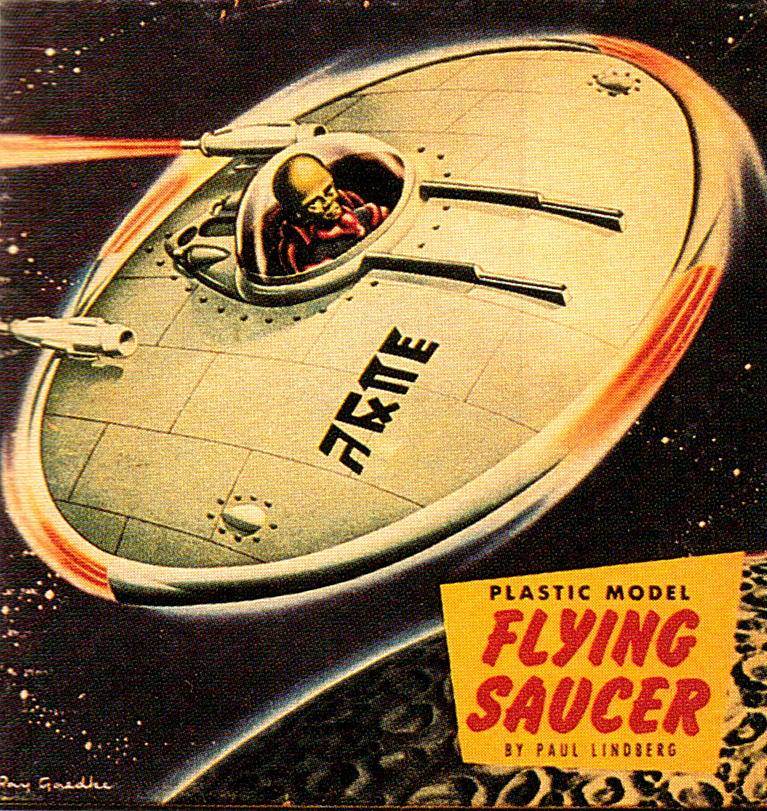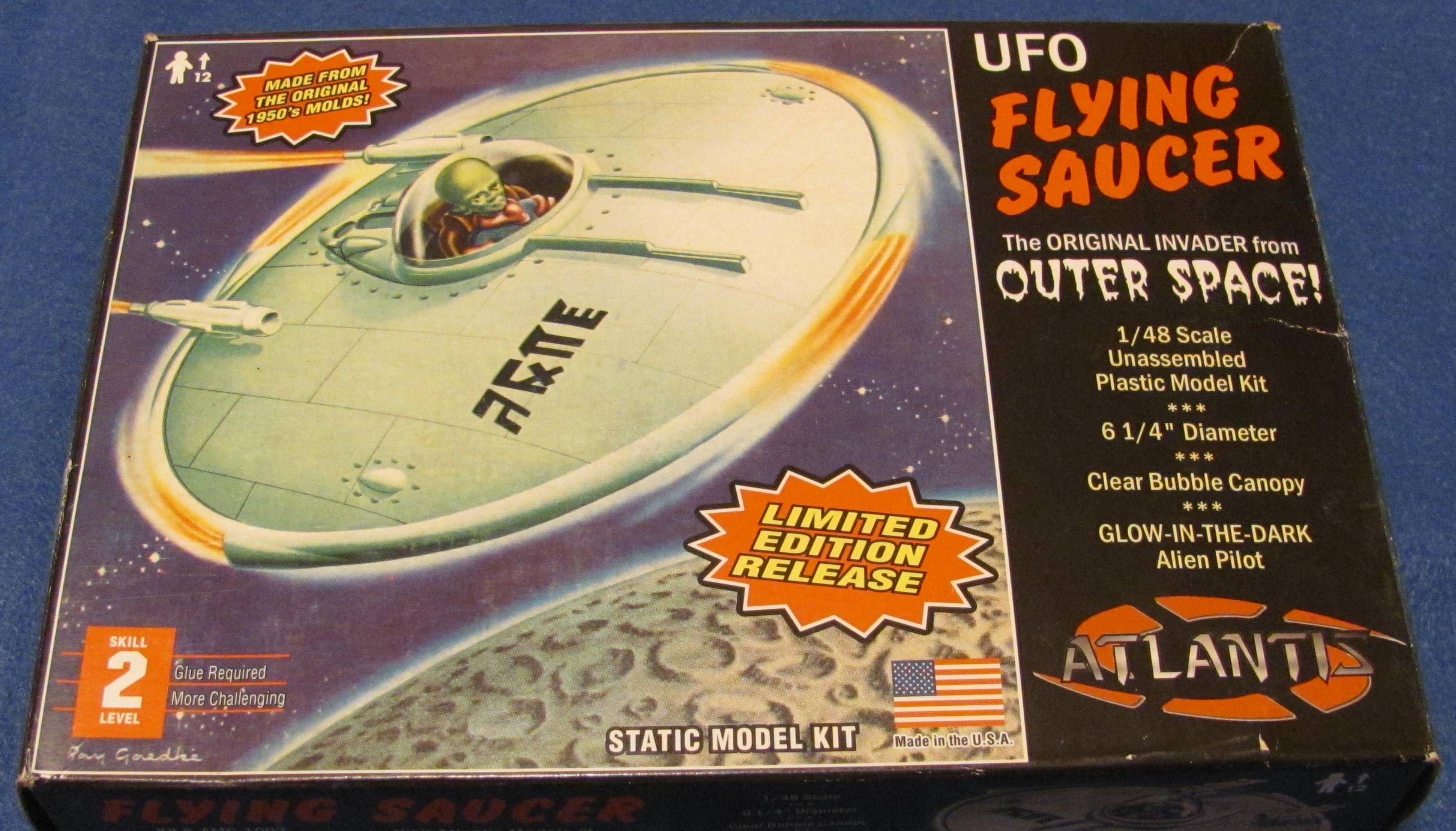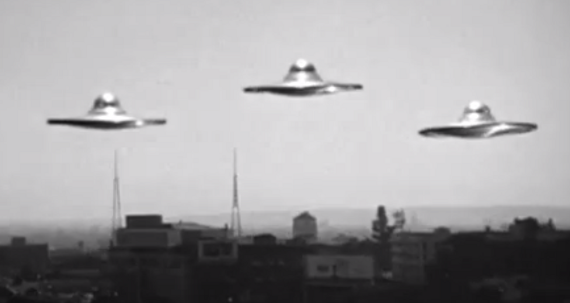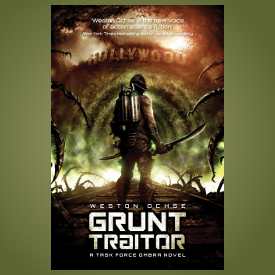Tim Burton’s movie ED WOOD is a genuine hoot, not least for the paper plate flying saucers shown dangling from wires. This maintains the mythology and mystique of the original movie, but happens to be incorrect.
As far back as 1980 the Medved Brother’s book THE GOLDEN TURKEY AWARDS quoted a production assistant as saying:
The flying saucers? I know they looked like pie tins, but they were actually paper plates. I mean, they were decorated and all, but basically they were paper plates. When we wanted to show the saucer blowing up at the end of the film, we soaked one of the paper plates in gasoline, lit it with a cigarette lighter, and then told someone to toss it toward the camera. It looked sensational.”
This falls under the category of “do not try this at home.” Consider how fast a paper plate soaked in gasoline would burn. Consider how you would grab this flaming plate and throw it (Frisbee style?) at a camera without yourself catching fire. Methinks this tale be suspect, especially since a shot of a burning saucer flying toward the viewer does not appear in the film.

In the October 1994 issue of Cinefantastique magazine Mark P. Carducci comments:
Popular legend had it they were, variously, paper plates, pie tins, or a Cadillac’s hubcap. Wood himself promulgated the hubcap myth. Admittedly, it made for a funnier story.”
A version of Ed Wood’s story appeared in Rudolph Grey’s 1992 Book NIGHTMARE OF ECSTASY: THE LIFE AND ART OF EDWARD D. WOOD JR. Like all of Wood’s pronouncements, it is far more confusing than it appears at first glance, and raises more questions than it answers.
Wood first says “We shot a square flying saucer in Karl Johnson’s garden.” Which didn’t work. Looked like a blimp. So then he “went down to a hobby shop and bought three model kits of flying saucers and they had these flat bottoms on them. That was why the bottom was square.”
Ed is referring to the fact that whenever you see actors entering or exiting the saucer you are looking at an exterior set depicting the corner of a presumably cube-shaped saucer bottom which had been determined by the shape of the ‘square’ saucer first filmed and subsequently rejected. How to jive the ‘cube’ with the circular store bought models?
In most saucer scenes in the movie all you see are the saucers, but in six of them you can observe a small square structure which had been added to the bottom of the saucer, including one glorious shot of the saucer hovering against clouds and slowly rotating to show off the cube. The other five depict landing or takeoff sequences, as if to suggest the square cabin was extended from the body of the saucer only when an undercarriage was needed. Certainly an interesting concept. Control cabin doubles as landing gear? Very Edwoodian.
Wood then goes on to claim the store bought models were made of balsa wood, that he dangled them flaming over a cardboard set of Hollywood, and that the burning balsa wood saucers kept falling on to the buildings and setting them on fire. Result? Saucers and buildings burned up and no useful footage. As he put it:
That ended the square gondola on the bottom of the round saucer even though I’ve already shot the film of the square gondola for the interior shots.”
He seems to imply the balsa models had square bottoms and now that he had ruined them, he would have to forget about filming saucers with cubes on their bottoms, unless he could buy more kits.
I went to Reginald Denny’s hobby shop and they didn’t have any more models… kids were buying them up as if they were going out of style.”
He decided to farm out the saucer effects to Ray Mercer’s film effects company. Mercer allegedly came up with the idea of using Cadillac hubcaps shot against black velvet and superimposed on stock footage of Hollywood. Certainly, unlike the Hollywood cardboard city set, these scenes DO appear in the film.
The question remains: what exactly are we looking at when we see the flying saucers in the movie?

From Wood’s tale I choose to believe the following: sometime in November of 1956 (when PLAN NINE was being filmed) he went to Reginald Denny’s hobby shop and bought three commercially available flying saucer models.
Were they balsa wood models? Of course not! The only flying saucer kit available was the world’s first PLASTIC SF kit, the FLYING SAUCER by Lindberg models, which originally came out in 1952 or 1954 (sources vary).
I had one as a little kid. I have distinct memories of grasping its hull (dinner plate size I swear) and hurling it Frisbee style for 100 feet or more. However, I need to adjust my memory a bit considering how small my hands were back then. In truth the Lindberg saucer is only six inches in diameter, and it probably ‘flew’ about ten feet, maybe. Still, it was loads of fun, considering the Frisbee had not yet been invented.
The Lindberg saucer has numerous distinctive details: a very flat disc-shaped profile, a prominent bubble canopy set within a ring-with-a-lip fairing with a teardrop shaped rear, a pronounced rim to the disc edge, four triangular rocket ports on the rim edge, two ‘machine gun’ ridges on the upper hull, likewise two ‘navigation light’ bumps, plus square paneling on the upper hull, and on the bottom hull unique triangular diaphragmatic striations culminating in a “flat bottom” with an extended socket into which fit’s the model’s stand. A plethora of details! How often are they visible in the film?
Note that I do not mention the two ‘rocket jets’ projecting fin-like from the upper hull. I assume Ed Wood discarded those since they would spoil the profile of the saucers.

In December of 1994 I sat down with three different videos of PLAN NINE and played the saucer scenes in each of them over and over, sometimes as many as twenty times, in an effort to match each shot with the details described above.
First of all, I was amazed to find a grand total of 51 saucer shots in the film. Very generous, considering how few special effects spaceship scenes you saw in the average B movie of the day.
I broke the saucer scenes down into the following categories:
23 – moving or hovering against cloud cover.
05 – above Hollywood at night.
05 – descending toward or taking off from graveyard.
03 – in vicinity of space station.
03 – against a ‘galaxy’ star field.
03 – burning above city lights.
03 – passing through mist or smoke.
03 – against backdrop of old Mission and mountains.
02 – as seen from car on highway.
01 – against backdrop of trees.
Of these 51 scenes, despite the poor quality of the videos I examined on a 14 inch TV, I ascertained beyond a shadow of a doubt that 29 out of the 51 scenes were DEFINITELY the Lindberg Saucer model.
These were:
20 (out of 23) moving or hovering against clouds scenes.
03 (all) of the ‘Galaxy’ backdrop scenes.
03 (all) of the burning saucer scenes.
03 (all) of the passing through mist or smoke scenes.
Is there a pattern to discern here? That 29 scenes were of the plastic model, the other 22 hubcaps? Nah. At the time I wrote up my research for my first issue of my perzine SPACE CADET I thought there was a chance 11 scenes could be hubcaps (though so blurry and featureless it was hard to tell) and the remaining 11 completely unknown in nature. Saying that SOME of the saucer shots were the Lindberg model was about as far as I could go.
Since then I acquired a reasonably good quality DVD and, although I have not subjected it to scene by scene analysis, have become convinced that the MAJORITY of the saucer scenes show the Lindberg model.
There is plenty of evidence to confirm this, including the PLAN NINE SAUCERS THEMSELVES!

It turns out that circa 1988 legendary prop collector Bob Burns purchased a ‘lot’ of film props (probably at an auction) from Ray Mercer Effects, the people who had done the optical effects for PLAN NINE. Included were two of the saucers used in the movie (the third had been sacrificed in the saucer-on-fire scenes and subsequently thrown away). Both are sans rocket jets (as I would expect), but one has a most telling detail, namely a square patch of dried glue on the bottom where a small cube of wood had once been affixed. AHA!
A photo of these two saucers can be found in Bob Burns’ excellent book IT CAME FROM BOB’S BASEMENT published in 2000 by Chronicle books of San Francisco.
Something puzzling though. One saucer is depicted bottom up to show the glue patch, the other top up to show the detail on the upper hull. The detail in both being so fine, and swirl flaws in the plastic being visible, I am forced to conclude these models are unpainted. Furthermore, details in the cockpit of the upright saucer (sans pilot) can be seen, proving that the bubble canopy is also unpainted.
Odd. According to Ed Wood his Cinematographer Bill Thompson didn’t like the ‘hubcaps’ being bright silver as they were too hard to light. So he painted them green. Wood hated the result and ordered them painted beige. Thompson threw a fit, yelling in anger. So Wood put his foot down and ordered them painted silver because that’s what everyone said genuine flying saucers looked like. He later admitted Thompson had been right:
“…because they practically glowed on the screen, but we didn’t have the money to correct them in the labs.”
Hmmm. How to make sense of this? Given that the saucer scenes used in the film were shot by Ray Mercer’s Effects, I’m not sure Bill Thompson was even involved. Or perhaps some scenes, the ones without superimposition, were shot by Thompson independently of Mercer’s company? Yet most of the shots devoid of special effects, scenes which merely depict the saucers hovering before simple backdrops, are definitely views of the Lindberg model, which strongly suggests, along with the fact the Mercer Company owned at least two saucer models, that ALL the saucer scenes, regardless of who filmed them, were of the Lindberg model. Could Ed Wood simply have been indulging in his penchant for telling tall tales?
It is a fact the saucers appear to glow in many a scene. Not sure that silver paint is required to achieve this. I think strong studio lights would reflect off the grey plastic of the hull and clear plastic of the canopy more than enough to achieve this effect.
On the other hand, some scenes show the bubble canopy disproportionately large. A trick of the lighting, or was something glued over the canopy to increase its bulk?
Knowing Ed Wood, he was liable to improvise at the drop of a hat. Who knows what he did to those saucers for any given shot?
I admit the subject hardly merits further research, so at this point I will say, all things considered, my opinion is that ALL the saucer scenes in PLAN NINE are indeed the Lindberg model. The Ed Wood paper hubcap space fleet is a myth.
NOTE: the painted version of the Lindberg Saucer in the illustrations is from the 1977 Glencoe issue. The unassembled parts are from the 2009 Atlantis issue.












